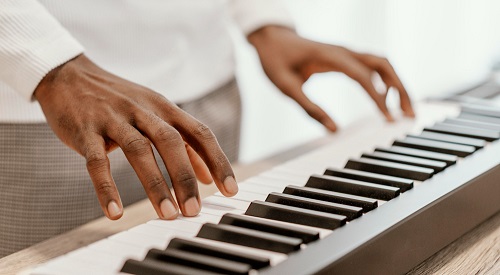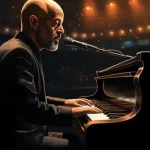Mechanical keyboard instruments
Keyboard instruments are a type of musical instrument that have been around for centuries, with the hydraulis (a water organ) being one of the earliest examples dating back to the 3rd century. Usually classified as either chordophones or aerophones, it can be played either by pressing keys on a keyboard, or by using a system of levers, buttons, or pedals. During the 14th century CE, additional keyboard instruments were developed, including the clavichord and harpsichord.
The clavichord is a keyboard instrument in which the strings are struck by tangents, while the harpsichord is a keyboard instrument in which the strings are plucked by quills. The pianoforte was invented in the 18th century and quickly became popular due to its distinctive sound and increased range. The piano allowed for a greater range of dynamics and expression than its predecessors, making it a favorite among composers and performers alike. As technology improved, more advanced musical keyboards were developed. New features were added, such as the ability to create different sounds and noises. The size of the keyboard also increased, making it easier for people to play.
Early electrified keyboards
This was done by studying the behavior of sound waves and experimenting with different ways to create and control them. Once this was understood, what followed was to apply this knowledge and technology to create keyboard instruments that could be played using electricity.
The earliest electric musical instrument ever created was the Denis d'or stringed instrument, made in 1748 by Václav Prokop Diviš. This innovative instrument paved the way for all future electric musical instruments, and is therefore a truly remarkable invention. The Denis d'or utilized a metal rod running through the center of each string that acted as a conductor for an electrical current. This allowed the instrument to be amplified without the use of acoustical means.
Elisha Gray's musical telegraph, invented in 1874, was an electric musical instrument that allowed for the transmission of music over telegraph wires. The sound was created by the movement of the electrons in the circuit, which caused a disturbance in the surrounding air molecules. This disturbance propagated through the air as a sound wave. A basic single note oscillator and a loudspeaker were later incorporated into his machine to make the notes audible. This was a major development as it meant that his machine could now be used to create music.
Electric keyboards and synthesizers
In 1906, Lee de Forest led the way in electronic valve innovation with the invention of the triode. This was a significant invention because it was the first time that electricity could be used to control a beam of electrons. The triode allowed for greater control over the electrical current, which made it possible to create more sophisticated electronic devices. In 1915, he invented the first vacuum tube instrument, which he called the audio piano. This early version of the electronic keyboard was made up of a series of vacuum tubes that amplified sound waves.
The Hammond organ was launched in 1935 and quickly became a popular choice for musicians looking for a portable organ that could create a range of sounds. The Hammond made the most from preceding production efforts, like the Robb Wave Organ from 1923, and quickly became a mainstay in churches, homes, and music venues around the world. In 1929, the electric piano was invented and was designed to imitate the sound of a traditional piano.
In 1939, the Hammond Corporation introduced the Novachord, one of the first polyphonic synthesizers. The Novachord was originally developed as an electronic organ and released to the consumer market in 1942. It featured 72 keys, each with its own individual note oscillator and amplifier. The instrument also had a built-in envelope generator and low-frequency oscillator for vibrato and tremolo effects.
In 1941, Georges Jenny's Ondioline became the first truly compact synthesizer keyboard. The Ondioline was a portable electronic instrument that was played by pressing keys on a keyboard. It was also the first electronic instrument to use reed-solicitors for sound production. Between the late 1940s and early 1950s, further developments were made with the Chamberlin Music Maker and the Mellotron. One of the earliest steps towards the creation of the electric piano was initiated by Harold Rhodes, who created numerous prototypes using bits from B-17 aircrafts that were being discarded. Harold Rhodes' work laid the foundation for future engineers to create instruments that would be powered by electricity.
The Wurlitzer Company released its first electric piano, the model 100, in 1955. The instrument was an immediate success and helped to cement the company's reputation as a leading manufacturer of quality keyboard instruments. This invention of the transistor in 1959 paved the way for increasingly smaller keyboards. The advances in miniaturization opened up a world of possibilities for electronics manufacturers, and the keyboard is just one example of how its impact is still felt today.
The combo organ was a popular instrument in this era, used by famous bands like the Doors as well as the Beatles. The Gibson G101 was an exceptionally popular model, but there were also many other brands like Wurlitzer, Acetone (Roland), Farfisa and others.
Synthesizers
The 1960's were the heyday of musical synthesizer exploration, which lead to the introduction of the modern keyboard. This new type of instrument allowed for a wider range of sounds and textures, giving composers and performers a greater degree of control over their music. The introduction of the electronic keyboard changed the landscape of music forever, opening up new possibilities for creativity and expression.
In 1964, Bob Moog produced his groundbreaking Moog synthesizer. This instrument revolutionized the way music was made, and shaped the sound of popular music for decades to come. The remote keyboard allowed the device to be used without being directly connected to it, and the modular design made it possible to reconfigure the components without having to replace the entire unit. In 1970, his next generation of Moog synthesizers was equipped with a built-in keyboard, called the Mini-Moog. This made the instrument much more portable and affordable, opening it up to a wider range of users. With its user-friendly interface and compact size, the Mini-Moog quickly became one of the most popular synthesizers on the market.
Duo-phonic instruments were used in 1972, which allowed for the creation of two different tones at the same time. This type of instrument was perfect for creating a more complex soundscape and expanding the possibilities for music composition. Yamaha produced a four-voice synthesizer in 1976, which didn't need to be specifically arranged in order to sound the same. This was very popular, and there were many entries followed by a sea of others.
The Yamaha GX-1 was produced in 1973 as Yamaha's answer to the VCS 3. The GX-1 featured a full polyphonic 49-note keyboard with velocity and aftertouch sensitivity. It was one of the first polyphonic synthesizers and is considered by many to be one of the finest analog synthesizers ever made.
In 1974, the Roland Corporation released their EP-30, a touch-sensitive keyboard that was groundbreaking for its time. The innovative device allowed users to varied dynamics and volumes simply by varying the pressure on the keys. In addition to releasing early polyphonic string synthesizers, Roland also released the RS-101 in 1975 and the RS-202 in 1976. These synthesizers were some of the first of their kind and allowed for a much wider range of sound than previous synthesizers.
The Yamaha CS-60 and CS-80 polyphonic synthesizers carried out 'memory' in 1976. This allowed for the storage of settings and recall of those settings at a later time. However, it was just an option hidden behind a hatch. The Oberheim OB-1, released in 1978, was one of the first synthesizers to feature actual electronic storage of sound settings making it a pioneering instrument at the time. The Sequential Circuits Prophet-5, which was released the same year, offered this feature in a five voice polyphonic synthesizer. This synthesizer allowed users to create sounds that were not possible with other synthesizers on the market at the time.
While Dave Smith's firm was responsible for a number of firsts, the most notable may be the Fender Rhodes Chroma. This keyboard was the first to be controlled by a computer, and was completed after Fender's acquisition of the struggling business in 1979. The addition of the ARP engineers to the Fender team proved invaluable in bringing this innovative product to market. The Apple computer, released in 1981, allowed users to run sequencing software that made it easy to program which notes were hit at particular moments in song production. However, the 'Chroma' port only emerged next-in-line of the Apple computer, the Chroma Polaris, which was released in 1984.
MIDI keyboards
In order to standardize the transfer of digital code, MIDI was created in 1983. This innovation sparked further groundbreaking progress in keyboard technology by allowing keyboards from various manufacturers to talk to one another using a low-cost cable, jack, and code set. The Yamaha DX7 was the world's first commercial digital synthesizer and it used entirely digital circuitry, which eliminated the need for calibration. It also had vast numbers of parameters that could be accessed, making it much more versatile than earlier analog synthesizers.
There has been relatively little exploration of the potential of frequency modulation (FM) synthesis. FM synthesis creates complex sounds by modulating the frequency of one waveform with another, and this technique can produce a wide range of sounds, from percussion to bells to leads. FM synthesis can be used to create both simple and complex sounds, making it a versatile tool for sound design.
In 1983, Dave Smith's company released the Six-Trak, the first polyphonic synthesizer that could play multiple sounds simultaneously. This groundbreaking instrument allowed users to create richer and more complex sounds than ever before, giving them unprecedented control over their music. The Six-Trak quickly became a favorite among musicians of all genres, and its success paved the way for many other great polyphonic synthesizers that would follow in its footsteps.
In the same year, the SCI Prophet T8 became the first piano action reproducing MIDI keyboard . This new technology allowed pianists to have more control over their sound by allowing them to send MIDI messages to external devices.
As ARP's popularity waned, the companies that produced analog synthesizers were feeling the stress of the newly popular digital synths. With fewer and fewer people interested in buying analog synths, these companies were struggling to stay afloat. Roland and Korg, two Japanese companies, developed innovative keyboards that became popular in the late 1980s. The Roland D-50 and the Korg M1 were both successful products.
The Yamaha DX series reached over a million in unit sales, with the others from Roland and Korg surpassing above 250,000. This success can be attributed to the innovative design of the DX series, which set it apart from the competition. M1 and D-50's triumph was made possible by the Kurzweil K250, which used this technology effectively as early as 1984.
This device was the first completely digital workstation with the ability to record acoustic sounds using a microphone and play them back at a pace inversely proportional to the note being struck. This meant that it could take a recorded sound, like someone playing the piano, and then play it back faster or slower without affecting the pitch of the original recording. The unit includes many great samples, including a piano sound that is still used in the 2000s.
To sum things up, electric keyboards were invented as an alternative to acoustic pianos. Acoustic pianos have a lot of moving parts and are typically very heavy, making them difficult to transport. Electric pianos are much more portable and can be plugged into an amplifier to make the sound louder, making them a more convenient option for musicians.
Harlan Kilstein began playing piano during covid with no piano background at all. He taught himself how to play learning what to do and what not to do.
Today he's an advanced intermediate player and can help you grow in your skills because he learned all this on his own.








